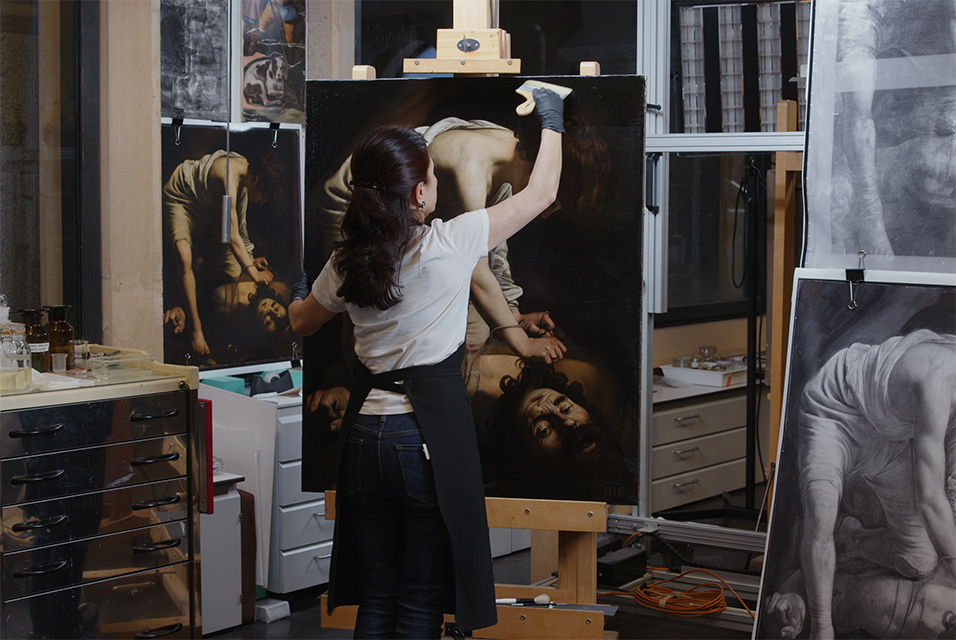The Museo del Prado is displaying its Caravaggio following Restoration

With the support of Fundación Iberdrola España, a Protector sponsor of the Museo del Prado’s Restoration Programme, the painting, an example of Caravaggio’s outstanding originality, has undergone a process of restoration to remove layers of oxidised and opaque varnish from the surface with the aim of recovering the work’s chromatic range and contrasts.
This procedure, undertaken by Almudena Sánchez, a restorer at the Museo del Prado, has reinstated the work’s original values and revealed elements in the composition previously concealed by the opaqueness of the varnish, such as the light surrounding the young David’s head and the foreshortened body of Goliath.
The painting is now on display as part of the new installation of Rooms 7 and 7A, for which David García Cueto, Head of the Department of Italian and French Painting up to 1800, has devised a panoramic vision of the phenomenon of Caravaggism.

Image of the David with the Head of Goliath Caravaggio in room 7A at the Museo Nacional del Prado. Photo © Museo Nacional del Prado.
Presented today by the Museo del Prado in Room 7A of the Villanueva Building is the painting David and Goliath by Caravaggio, following its extensive restoration within the context of the programme sponsored by Fundación Iberdrola España.
The principal aim of this restoration has been to reinstate the original image devised by Michelangelo Merisi, “il Caravaggio”, which had been disappearing over time beneath layers of dirt and oxidised varnish. The opaque nature of these old layers of varnish eliminated the space and depth in the composition. This made it more difficult to perceive the dimensions of the place in which David and Goliath are located, given that within the scene as a whole it was only possible to distinguish the parts of the figures brightly illuminated by the focused light source.
This issue was also partly the result of previous selective cleanings, which had essentially concentrated on the foreground planes and the most brightly lit parts of both figures, ignoring the background of the composition and the areas in shadow. The result was to gradually transform Caravaggio’s original chiaroscuro into a violent contrast of light and dark, leaving the figure of David outlined against a flat black background. The composition was consequently reduced to a single plane.
The yellowish tone of the old varnish altered Caravaggio’s original colours, giving a warmth to the pale, luminous tones of the flesh and clothing which totally modified the artist’s concept. In turn, the loss of transparency in the varnish blurred the volumes and eliminated the elements located in the background and in the areas of shadow. In these conditions it was only possible to appreciate the scene depicted by Caravaggio in a partial manner.
Technical analyses using infrared reflectography and X-radiography have revealed the work’s state of preservation as well as the artist’s creative process.
Thanks to the painting’s excellent condition it is possible to appreciate the glazes and half-tones; subtle, fragile layers that provide extensive information on Caravaggio’s remarkable technique.
With regard to the creative process, there are notable changes to the composition, such as Goliath’s startling, still living face, with its dramatic expression, staring eyes and mouth half-open in a gesture of horror. One of the most impactful elements is the giant’s foreshortened body, in particular his buttocks on the right side of the painting and continuing with his leg which rises up behind David towards the upper part of the canvas in an image that shows Goliath’s body thrown to the ground after being hit by the young shepherd’s sling. The present restoration has similarly reinstated the space surrounding Goliath’s head and trunk on the ground as well as his arm, which passes behind David’s leg and emerges with the clenched fist facing forwards.
Another totally unexpected element that reappeared after cleaning is the pale light surrounding David’s head, a light that is cut diagonally by a dark shadow which defines the dimension of the background space. The present cleaning process has also succeeded in reinstating the composition’s successive planes and the air that circulates around the figure of David, which were both previously imperceptible. Furthermore, it is now possible to appreciate the complexity of the composition, the result of the tiny space in which the artist located the two figures, a rectangular space suggestive of a deep box.
Analysis using X-radiography has revealed the existence of two specific areas of damage which must have been produced accidentally. The more significant one is on the sleeve of David’s shirt and the other is on his knee and continues into Goliath’s shoulder. Both had very old restorations that affected the original paint, which has been reinstated in the present procedure through the removal of these repaints. Losses of pigment in these two areas were filled in on the pictorial surface using chromatic reintegration.
According to Almudena Sánchez, the restorer who has undertaken the project: “This restoration reveals a new Caravaggio, giving us a previously unknown image of the painting, the true image of this great masterpiece which after so long in the shadow has recovered the light with which it was originally conceived.”
